Edited: after information received yesterday, I realised I had a senior moment and some of the information in the original post was incorrect.
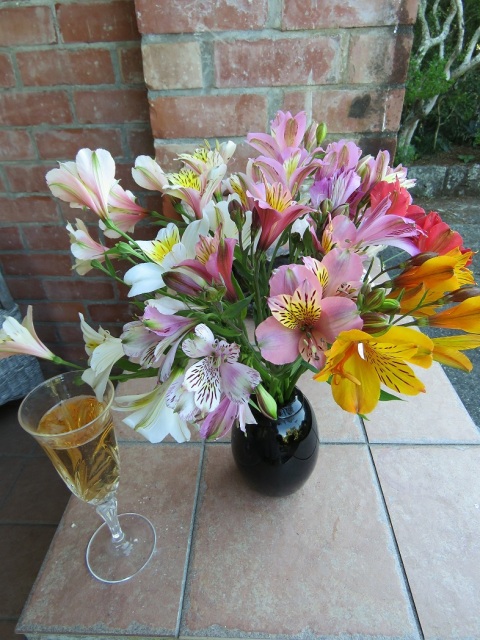
I don’t have a big collection of alstromerias and the tall ones can be bothersome as garden plants but I do quite like them. When I gathered them up, I seem to have about ten different ones, all ‘acquired’ as I say. This is not a plant family I have felt the need to go out and buy.
Why bothersome? They have a tendency to spread if left to their own devices. Some may call them invasive. They are difficult to eradicate because any parts of the fleshy tubers left behind will grow again. But the big problem is that the tall ones that I favour need staking. The stems are rarely strong enough to hold them up on their own.
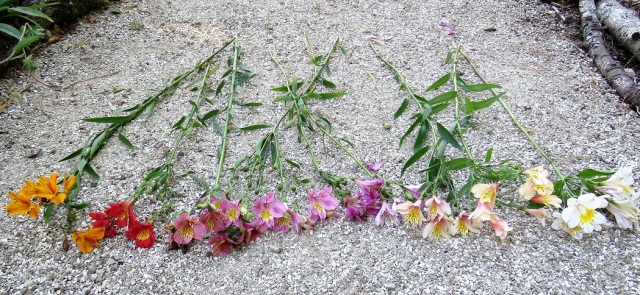
Alstromerias are much favoured as a cut flower, but I don’t often cut flowers to bring indoors. Every window in our house looks out onto gardens so it seems a bit unnecessary to bring flowers indoors to die. We don’t feel the need of house plants either. Alstros are sometimes called Peruvian lilies and the family tree does trace back to the lily group but their homeland is not limited to Peru. There are many different species found widely throughout South and Central America. The ever-handy Wikipedia tells me that most of our garden plants are hybrids between winter-growing species from Chile and summer-growing species from Brazil. They certainly have a long flowering season.
Some years ago, the ‘Princess lilies’ group hit the shelves in plant shops here and I sniffily dismissed them as part of the dwarfing down of fine big plants to make something like traffic island bedding plants. I never even bothered to look at them. Then I was given a white form and my dismissive attitude continued but I divided it up and planted it out. For the next two years, they still looked like tidy, traffic island, bedding plants to me. I didn’t like them and I still don’t. *Dot plants*, to coin a phrase from early Alan Titchmarsh.
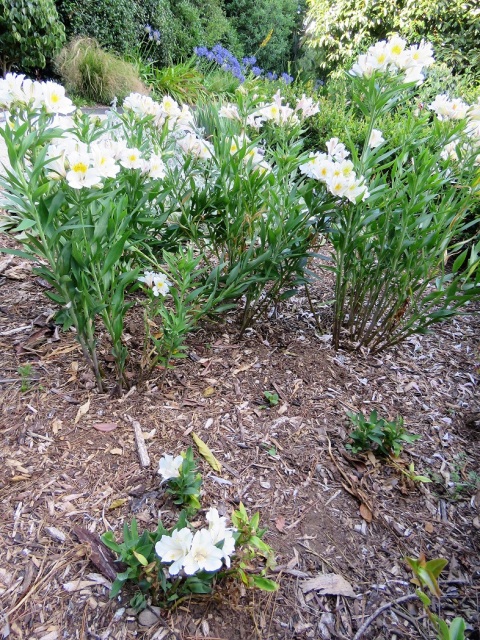
Until yesterday, I thought my intermediate-sized white alstros that were delighting me this summer were that Princess series dot plant putting itself on steroids. In self-defence, plants that are dwarf in different climates can surprise us in our benign conditions and romp away well beyond their predicted size. But it was a senior moment on my part. I had forgotten entirely that a gardening friend gave these to me last year. It turns out there is a whole other alstromeria series that has been released internationally – including NZ – and these are from the Paradise Summer series. This one is, apparently, ‘Summer Sky’. They are an intermediate size and generally strong enough to hold themselves up.
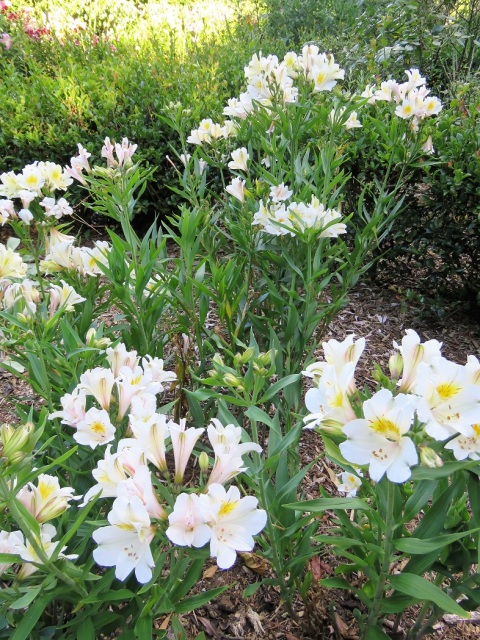
I looked up both the ‘Princess lily’ and ‘Paradise Summer’ series and both seem to have come from Dutch breeders. No surprises there. The Dutch do a lot of plant breeding and especially in the area of flowers for floristry or mass plantings.
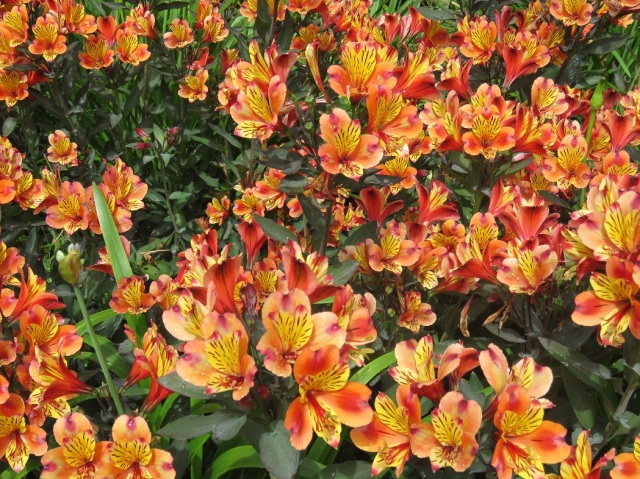
Two gardening friends have waxed eloquent about the merits of an orange flowered one with burgundy foliage. I think it is probably ‘Indian Summer’ and likely the same as this one I photographed at RHS Wisley some years ago. I can see it is an excellent performer but I think it is a bit garish, a bit ‘look at me! Look at me!’ for my taste. But maybe I could use it in the sunny borders. It is from the Paradise Summer series too. I may have to take a closer look at the other selections available in this group because there is a whole range of colours now available.
Finally, two bits of advice about alstromerias. Firstly, they benefit from being deadheaded. As long as your plant is well rooted in the ground, the advice from the professionals is to grab the spent flowering stem and tug the whole thing out of the ground rather than cutting it. The same goes for picking them. It is easier than cutting each stem and it leaves a cleaner plant.
Secondly, plant the tall varieties in groups, not drifts. I managed to get around all my clumps in the twin borders this year with stakes (forked pieces of dead yew branches in this case which become invisible, unlike bamboo stakes) and that has largely worked well to keep the flowers up. Where I planted them in drifts in the Iolanthe garden they are chaotic. Zach asked me recently if I had any advice on how to stake them and I didn’t. As soon as it rains, we will dig them and consolidate them into clumps that can be staked.
There is always room for improvement in gardening.
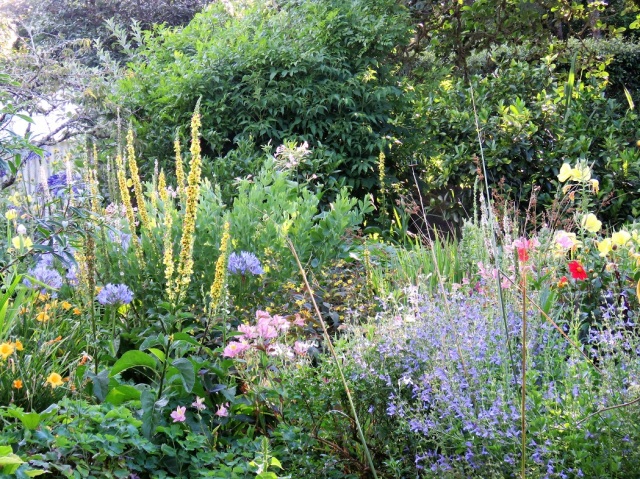

Hi Abbie, it is interesting that you mentioned the compact alstroemeria growing taller than expected. In one of the gardens I work in there are several clumps of various colours that appear to have done the same thing. I’m wondering if it is something to do with the wet mild spring we had?
Regards
Mark
I have no idea! I do hope my nice white ones don’t go back to being bedding plants next season!
Generally, I regard the alstromerias as nuisance plants – too lax, demanding of support and spreading too much. We grow one called ‘Indian Summer’ – quite close in colour to your last photograph – and I consider that one worth growing.
I think that is the name of the one both my gardening friends praised, and quite possibly the one I photographed at Wisley.
Alstromerias have to be one of my favourite plants for their profusion of summer blooms. Unfortunately my alstromerias caught the mosaic virus so I have removed them this year. 😭 😭